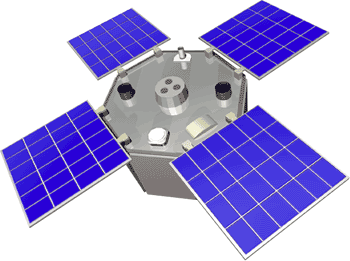 Earth’s
closest star, our sun, provides the key energy input that drives global weather
patterns on our home planet. Scientists studying global climate change now
believe that small, sustained changes in the energy coming from the sun (called
total solar irradiance) could play a role in climate change on time scales of
many decades. By measuring the total amount of energy that the sun delivers to
the Earth, scientists will be able to build better scientific models of the
Earth’s climate system, providing a vital piece of the global climate change
puzzle. Earth’s
closest star, our sun, provides the key energy input that drives global weather
patterns on our home planet. Scientists studying global climate change now
believe that small, sustained changes in the energy coming from the sun (called
total solar irradiance) could play a role in climate change on time scales of
many decades. By measuring the total amount of energy that the sun delivers to
the Earth, scientists will be able to build better scientific models of the
Earth’s climate system, providing a vital piece of the global climate change
puzzle.
How sunlight drives the Earth system
The sun has been powering the
Earth system for the past 4.6 billion years. Since most of the sun’s heat is
deposited into the tropics of the Earth, the polar latitudes receive on average
much less solar heating than the equator. As a result, the average difference in
solar heating between the equator and the poles is large. This situation drives
a strong “heat engine,” or circulation of the atmosphere, steering weather
systems around the globe. In addition, the sun is a major player in the
hydrologic cycle, as a steady influx of solar energy induces continual phase
changes in water. As incoming solar energy heats the surface layers of the
Earth’s oceans, lakes, and rivers, some of the water molecules break away to
form water vapor in the atmosphere. This water vapor rises high into the
atmosphere where it condenses into clouds, and eventually precipitation, and
falls back to the surface where the cycle begins again. These precipitation
processes lead to the weathering of rocks and erosion processes, which shape
Earth’s landscapes. Through photosynthesis, sunlight is used by green plants to
reduce carbon dioxide in the atmosphere and convert it to carbohydrates and
oxygen, an essential process for the sustainability of life on our
planet.
|
|
by Steve Graham
December 21, 1999
 ACRIMSAT
Introduction
Variations in Total Solar Irradiance
Total Solar Irradiance Data in Climate Studies
Total Solar Irradiance Data in Solar Studies
Related Sites
ACRIM Instruments
ACRIMSAT
top left: Image of the sun from the Solar and
Heliospheric Observatory’s (SOHO) Michelson Doppler Imager.
(Image courtesy NASA Goddard Space Flight Center) |
 Scientists will
acquire new solar data from NASA’s ACRIMSAT spacecraft, a five-year mission launched on December 20, 1999 that
will measure the sun’s total solar irradiance with the Earth Observing System’s
(EOS) Active Cavity Radiometer Irradiance Monitor (ACRIM) III instrument. This
instrument, the third in a series of long-term solar-monitoring tools built for
NASA by the Jet Propulsion Laboratory (JPL), will extend the database first
created by ACRIM I, which was launched in 1980 on the Solar Maximum Mission
spacecraft, and ACRIM II, which is still flying on the Upper Atmosphere Research
Satellite (UARS) launched in 1991. The ACRIM III design is based on the same
sensor technology design used in ACRIM I and ACRIM II.
next: Variations in Total Solar
Irradiance |
|
left: The ACRIM satellite will monitor the total energy emitted by
the sun for five years, beginning in December, 1999. An
animation (1.5 MB Quicktime) shows the satellite
deploying its solar panels. (Image courtesy
ACRIM Project, JPL) |



